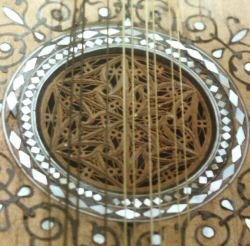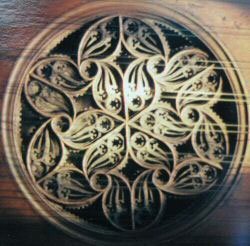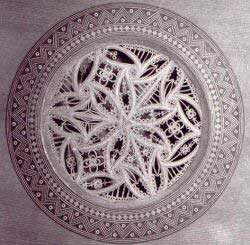
Ornamental detail from a Koran produced in Valencia, Spain 1182-3.
*
* *
Roses
in late 16th – early
17th century vihuelas: some thoughts and ideas.
One
of the most fascinating of 28 historical documents recently
published, “Inventory and valuation of the workshop
contents of the violero Mateo de Arratia of Toledo”, dated 30 June 1575
[1], contains the following entry: two new vihuelas in
Portuguese ebony, one with a sunken rose (lazo hondo) and
the other with a rose
in the soundboard (lazo en la tapa). Reference to the
type of roses used in instruments is not just restricted
to this particular account
and seems to have served as one of the main defining characteristics
(together with the instrument’s body type) in descriptions
of the vihuela and the guitar. In certain cases, as we will see further,
apart from being a purely constructional reference, it also tells
us how the makers’ skills and abilities were judged and differentiated.
The main purpose of the present study, however, is to try to establish
what could have been meant by these two definitions: ‘lazo
hondo’ and ‘lazo en la tapa’.
Firstly ‘lazo
hondo’; the most obvious analogy that
comes to mind is a type of multi leveled rose with progressively
descending patterns into the inside of the instrument’s
body. Roses of this type can be found on a relatively large number
of surviving
instruments, not only guitars but also citterns, harpsichords
and even viols from the late 16th - early 18th century. Most
often these “three-dimensional” roses
are made entirely of parchment although occasionally upper
layers of their ornamental patterns could have been made
of wood as well.
The other type of the rose, which is equally well represented
on the instruments of the above-mentioned period, consists,
as a rule,
of several very thin layers of wood and parchment arranged
in a sandwich-like way. It does not sink so deeply into the
inside of the instrument
(the overall thickness of the rose of this type can be as
little as c 1.0 mm) but is set just below the beveled edge
of the sound
hole [see images 1, 2 & 3]. Therefore,
to a certain degree, it can also be classified as ‘lazo hondo’ but
whether this is really so will remain to be determined. The
rose on the vihuela E. 0748 from the collection of the Cite
de la Musique
belongs to this latter type [2]. Only small fractions of
the rose on the Quito vihuela are preserved, so one can not
be exactly sure
of its original method of construction, although from what
looks like fragments of parchment around the perimeter of
the sound hole,
it could have been of a sunken, ‘lazo hondo’ type
[3].
The
presence of these two types of roses on the earliest surviving
guitars is particularly important for us because their constructional
features (and, as a result, their acoustical properties too)
may well be in many ways very close, if not identical to those
of the
late 16th – early 17th century vihuelas [4]. This idea
of similarity of approach to the construction of the vihuela
and the guitar is
evidenced, for example, in the “Certificate of
examination of Juan Rodriguez” of 27 December 1578 which states that: “… examiners
of the craft of violeros … have examined the journeyman Juan
Rodriguez in the making of a vihuela with a sunken rose and a guitar
in the same manner…(una bihuela con lazo hondo y en
una guirarra de la misma manera)” [5]. Although, apart from the type of
the rose, no other distinct characteristics of the instruments
are given, they were most probably of a plain (llana) type, in
other
words, with flat backs. This point becomes more evident from the
account that follows below and can be further exemplified by the
fact that this examination was carried out on a journeyman, who
was only about to embark on his new career as an independent violero.
The “Certificate of examination for the violero Pedro Tofiño” of
1588 presents us with a more differentiated approach when it comes
to the matter of roses and may bring us a bit closer to understanding
why the choice of rose type was such an important issue: “The
said overseers and examiners … have examined the said Pedro
Tofiño on a plain vihuela and on a cittern with a sunken rose
(una vihuela llana y una citara con lazos hondos), which the said
Pedro Tofiño made in their presence, … and … agreed
and gave him a licence and faculty, as an accepted and examined master
craftsman in the making of a plain vihuela and a cittern with only
sunken roses, so he can, from this date onwards, freely make and
repair only that type of instrument … without hindrance or
penalty, as long as he does not make viols, harps or vaulted vihuelas,
or decorate the table with inlays, or with carved roses (no pueda
haver biguela de arco ni arpa ni biguela aconvada ni echar ataracea
ni lazo en la tapa) until he is examined again …” [6].
What
we may learn from this account first of all, is that
the level of a maker’s skill was measured by his ability
to execute certain carving procedures (as such instruments from
the ‘prohibited’ list,
as viols and harps would certainly require a higher
level of competence not only in carving but equally more complicated
assembling techniques).
As for the inlays (ataracea in this particular context
can also be interpreted as intarsia or mosaics),
they clearly denote (see also
Toledo 1617 account below) more elaborately made instruments,
for which this particular maker would still need to gain the
necessary
skills. In a way, the wording of the account seems
to echo the rather austere external features of the surviving
E.0748 vihuela (albeit
with a vaulted and fluted body) – plain, undecorated
soundboard with a “sunken” (?) rose and
with no ornamental inlays. Even more so, the very fact
that the sunken rose (lazo hondo) is
mentioned on both the vihuela and the cittern, with
no indications of the violeros’ own involvement
in its making, may simply mean that those roses were
already supplied pre-fabricated by craftsmen
of a dedicated trade [7]. Although no deep sunken rose
is present on the surviving vihuelas (except, perhaps,
on the Quito vihuela?),
they are well represented on both the early 17th – mid
18th century guitars as well as late 17th – early
18th century citterns.
As
for the “lazo en la tapa”, the apparently logical
interpretation that first comes to mind is for a “rose cut
in the soundboard wood”, in a similar way to roses in soundboards
of lutes. But can we really apply this seemingly obvious analogy
to the case of vihuelas? Neither iconographical nor written sources
are sufficiently detailed to provide any clearer idea for this important
but rather subtle organological feature of historical vihuela construction.
A fair degree of confusion, however, would inevitably arise if we
tried to imagine the lute-type of the rose in the soundboard of the
late 16th – early 17th century vihuela as well as its closest
historical companion - the guitar. No “lazo a la tapa”,
which is cut directly into the soundboard wood, is present on any
surviving guitars from the early 17th century onwards (please correct
me if I am not right!). It doesn’t even seem reasonable, taking
into account a fairly large number of surviving early – mid
17th century guitars, to admit the presence of a
rose of this type on the soundboard; the construction
of which is so fundamentally
different from that of the lute.
The
barring arrangement of the vihuela and guitar soundboard
as well as its thickness differ quite dramatically from a typical
lute
soundboard. The E.0748
vihuela has just two bars with “wedge” shaped bar end supports on the
sides of the instrument and a soundboard thickness ranging from 3.5
mm in the central area to 2.0 mm on the edges. Two soundboard bars
in combination with “tuning-fork” shaped bar end supports
are found on the Quito vihuela [8] and on one of the earliest surviving
late 16th – early 17th century Spanish guitar in the Convento
de la Encarnatión, Ávila [9]. Although
the original soundboard on the Belchior Dias instrument
did not survive, the
remains from the four bar end supports on its sides
suggest an identical
barring arrangement, with a possible proportional
reduction of the soundboard thickness (as compared
to the E.0748 vihuela) in
accordance
with the smaller size of the instrument.
The
two bars with accompanying bar end supports on
the sides remained, as the surviving instruments demonstrate, one
of the most characteristic
features of Spanish guitar construction up to the
mid 18th century when it gradually started to be replaced with
a fan-system of struts.
This, in turn, resulted in the use of thinner soundboards
(but still no roses cut ‘in a lute way’!) The very
idea of the two-bar arrangement would seem to preclude the use
of the lute-type of rose
altogether, both on the guitar and the vihuela.
For a rose to be cut in the soundboard of a lute, it has to be
thinned down in that
area to c. 1.0 mm, supported with a paper backing
and small bars underneath and from one to three cross bars for
its entire width.
This way of construction on the late 16th century
vihuela / guitar soundboard would look rather odd, hardly consistent
with its structural
and acoustical nature. Even if the rose is cut
in, say, a 2.5 – 3.0
mm thick spruce (!) soundboard, it would still
need to be supported from underneath with an additional barring
structure, which is again
contradictory to the idea of the two-bar arrangement.
Neither of these ways nor any traces of such have survived, at
least to my knowledge,
on the early 17th – mid 18th century guitars
of Iberian, Italian or French origin. It simply
lies beyond the logic of those two rather
differently structured instruments - the lute and
the vihuela. Interestingly enough, on some surviving
examples of late 16th – early 17th
century viols we seem to find examples
of both ‘lazo en la tapa’ and ‘lazo
hondo’ types
of roses. The first is represented with a two-layer
(wood and parchment) rose which is set flush with
the soundboard surface, while the second,
is with a sunken rose of a three-dimensional design [
see images 4, 5 & 6].
Some insights as to what might be hidden behind the definition
of ‘lazo
en la tapa’ emerge from the “Proposal
of Ordinances for the craft of violeros of
Toledo” of 1617. The section of this
document which deals with the examination procedure in the making
of “a plain six-course vihuela (una
biguela llana de seis ordehes) “ also
defines that “this instrument has
to have inlaid rings, an ebony fingerboard
and a boxwood rose with thirty-six points (este
ynstrumento a de llevar veril y plantilla de
hevano con un lazo de
box de treinta y seis)” [10]. A further reference towards the
end of the document, which aims to provide a sort of guidance for
vihuela repair, only re-confirms the earlier statement: “… if
anyone were to bring an ebony vihuela to have
a soundboard fitted, this [soundboard] must
be of spruce *pinewood* with
a rose of boxwood and not of parchment (que
si alguno ttrujere biguela de hebano para
que le hechen tapa que se le heche de pinay
bete *pino* y con lazo de boj y no de pergamino)”.
This description may well indeed represent
the ‘lazo en la tapa’ type of the
rose with inlayed rings surrounding it for
the purpose of disguising the border
of the inserted rose made of different material
than that of the spruce *pinewood*.
In addition, a carved boxwood rose would almost
certainly be of comparable thickness and of
a similar shade of colour as the soundboard,
which would make this ‘lazo en la tapa’ way
of construction even more logical.
This account is also, in a way, consistent with the above-mentioned
description of the examination of Pedro
Tofiño on a plain
vihuela and the use of ‘lazo hondo’,
which would most probably be made of parchment.
The only difference here lies clearly
in the matter of aesthetics, which seems
to have been ruled by the choice of corresponding
materials: an ebony vihuela – a
carved boxwood rose, a simpler, more modest
instrument by the beginning violero – a
parchment ‘lazo hondo’. At
least one of the surviving sources, however,
proves that it was not always
the case. An inventory dated 1580 lists: “… an
ebony guitar with a sunken rose, together
with its case, and an inscription
on the head that reads Juan Rodriguez (una
guitarra de ebano con el lazo hondo con
un letrero en la cabeza que dice Juan Rodreguez
con su caja)” [11]. Note that neither
of the documents mentions the procedures
of making roses as such, either of parchment
or
carved in boxwood. Equally so, neither
admits an alternative
construction of the rose, one which could
be cut directly into the soundboard
wood!
Boxwood
roses are also repeatedly mentioned between
1632 – 1636
on the instruments made by Pablo de Herrera
and Manuel de Vega, apparently on a cocobolo tiplecito (small
tiple) and guitars (some of them made
of Portuguese ebony) [12]. Additional evidence
that the carved vihuela roses might have been made of boxwood
later in the 17th century is
contained in the “Inventory of
the workshop contents of Antonio de Medina
at the time of his marriage to Catalina
Rodriguez” of
1674, which lists: Ebony, box and walnut
wood to make biguelas … (Ma
en Madera de hevano box y nogal para fabrica de biguelas…) [13]. This is the only instance related
to the vihuela in this rather extensive
listing of tools, equipment, materials
and instruments
(thirty-one guitars but also two harps and two archlutes) [14].
The
mentioning of a spruce *pinewood* soundboard
in the Toledo ordinances of 1617 together with the boxwood and
parchment roses
has some additional
significance for, as we can see in some
surviving late 16th – early
17th century citterns and even harpsichords
with the soundboards made of different materials than spruce
(notably cypress and cedar
of Lebanon), their roses can be cut directly
into the soundboard [see images 7, 8 & 9].
The manner of their execution, however, is somewhat different
and is more related to the actions of
carving and sawing than cutting. Differences in the ornamental
design, as compared with a typical
lute-type of the rose are also apparent.
In addition, there is also no noticeable thinning of
soundboard in the rose area. The
choice of a different soundboard material
here fulfils the purpose: carving in
harder, rather slab-cut
wood certainly proves ‘technologically’ more
consistent than in quarter-cut spruce
or pine and this is all too clearly
demonstrated by these examples.
On
the other hand, some surviving citterns
and viols with pine or spruce soundboards display a certain degree
of consistency with
the
above mentioned accounts related to
vihuelas and are fitted with either sunken (parchment) or flat
(sandwich layers of wood and
parchment)
roses. One of the examples of the latter
type of rose which is found on the late 16th century Italian
cittern made by Giovanni
Salvatori
[15], (and is of similar construction
to the rose on the E.0748 vihuela) in this case appears to be
inserted flush with the soundboard
surface
[see image 10].
This also gives us another possible
idea of how the multi layered wood
and parchment
type of roses could
have
been used in a “lazo en la tapa” sort
of way, in addition to the above mentioned
boxwood roses of the Toledo ordinances of
1617.
Let
us now turn again to the inventory
of the workshop contents of the violero Mateo de Arratia of Toledo
of 1575. This is one of
the most comprehensive of existing
listings of what might have been found in a workshop environment
of the 16th century Spanish
violero and it clearly shows
that this maker was almost certainly
of a higher degree of qualification
than,
for example, Pedro Tofiño of
Madrid. As for the subject of roses,
there is the following entry: Fourteen gouges thirteen with
boxwood handles to make roses and
one for general work (Qatorze guvias
las treze de hazer lazos con sus
qavos de boz y una del oficio).
Just to complement this, A
round piece of boxwood a yard long
with two other pieces half-sawn (Un
pedazo de box rredondo de una vara
de largo con otros dos pedaços
empeçados aserrar) is
also listed in this account. The
shear amount of these tools seems
hardly necessary for carving the
lute-type
of the rose, in particular in such
material as spruce. However, they
would certainly prove useful either
for cutting (some of these ‘gouges’ might
also be used as ‘punches’)
multi layered wood and parchment
or boxwood roses. The signs of usage
of these kinds of tools can
be seen on some original roses [see image 11].
A
similar set of tools for carving
roses is also mentioned almost one hundred years later in the “Inventory
of the workshop contents and belongings of Joseph Gonzalez made
after the death of his wife
Isabel de Ortega” of 1670 that lists “Nine gouges to
carve roses, one large and a broken burin” (Nueve
gubias de hacer lazos y otra gubie
grande y un zincel quebrado)” [16].
The
other entry from the account of
Mateo de Arratia of Toledo which, in a way, brings a totally different
dimension to our understanding
of how Spanish violeros approached
their business, by integrating trades from their recent imperial territories
- in this case from
none other than Venice! It reads
as follows: “Eighty-eight
tops from Venice with roses, at
three and a half reales (Ochenta y ocho tapas de las de venicia
con sus lazos a tres reales)”,
apparently the most expensively
valued entry of the account, at the equivalent of 10472 Maravedis.
Stocks
of soundboards are also mentioned in a number of other historical
accounts published in [1] but only that of Mateo
de Arratia informs us where they may
have originated from. There is no direct
reference in the surviving Ordinances that the
violeros were allowed to use ready-made parts, but it may be
that it was possible after they had
reached a certain degree of status in their career [17].
From
the names of the instruments
as well as the other items of equipment listed in the inventory,
it appears that at least the following
instruments were being made
in the workshop of Mateo de Arratia: vihuelas, guitars, citoles
(citolas), citterns (citara) and small
gitarrones (gitarrones
peqeños). At
the time being, it is only
possible to guess whether
such a massive stock of soundboards
had been prepared for vihuelas,
citterns or for the growing
demand
in guitars. One fact in relation
to roses, however, deserves
mentioning. The basic pattern
of the ornament of the rose
on the soundboard of
the E.0748 vihuela [18] is
identical, at least to my
knowledge, to roses in several
other surviving instruments:
two guitars, an Italian
harpsichord and a mandolino [see
image 12].
Therefore the possibility
is not excluded
that the
parchment roses mentioned
in the above quoted accounts
(or at least some of them)
were made
outside Spain, while those
carved of boxwood were supposed
to be made by the violeros
themselves and represented
the uniquely Spanish
trend in the historic vihuela (and, possibly, guitar) making
traditions.
At
least three varieties
of roses seem to have been used in the vihuelas and the guitars
made by the Spanish violeros in the late
16th – early 17 century:
1)
multi leveled“three dimensional” roses
made entirely of parchment,
2) multi layered“sandwich” roses
consisting of thin
layers of wood and
parchment,
3) roses carved of a solid piece of boxwood.
The
first and third types
are more likely to be associated with what the original sources
name as ‘lazo hondo’ and ‘lazo
a la tapa’ accordingly. The second type can possibly be classified
either as ‘lazo hondo’ if the rose is attached to the
inside of the sound hole, or ‘lazo a la tapa’ if it is
set flush with the soundboard surface. The third type is the most
likely candidate for the ‘lazo a la tapa’ type
of rose. The first
two types could have
been made either
by the violeros themselves
or, more likely, by craftsmen of the dedicated trades, while the
boxwood roses seem to have been made exclusively by the violeros. References
to boxwood roses
in Spanish documents
throughout the 17th
century and their
apparent absence
on the surviving
early – late
17th century Italian and French guitars may indicate that this type
of rose was uniquely reserved for the late 16th – early
18th century Spanish
vihuela and guitar
making tradition.
As
the use of harder
varieties of wood other than quarter-cut spruce or fir (such as
cypress) on gut-strung plucked instruments
of the
late 16th – early 17th centuries (namely guitars and vihuelas)
does not seem to coincide with their constructional and acoustical
principles - as is overwhelmingly manifested in the surviving vihuelas
and early 17th century guitars; the use of roses cut directly into
the soundboard wood equally seems as an unlikely idea. Therefore
the association of what historical sources describe as ‘lazo
a la tapa’ with
roses cut directly
into the soundboard
wood should most
probably be ruled
out.
[1]
José L.
Romanillos
Vega & Marian
Harris Winspear:
The Vihuela
de Mano and
the Spanish
Guitar (VMSG),
The Sanguino
Press, Guifosa 2002, pp. 479 - 482
[2]
Illustrated
in Aux origines de la guitare: la vihuela de mano, Cité de
la Musique, Paris 2004, p. 67
[3]
Illustrated
in The Spanish Guitar, New York – Madrid,
1991 – 1992
[4]
The idea
that the vihuelas could also have been re-used as guitars, on
the wave of the growing popularity of the latter towards
the
end of the 16th – early 17th century, is vividly expressed
in the following document, Declaration by the examiners
of the Guild of violeros about the examination of Francisco de
Lipuste: “The
said
examiners exhibited and demonstrated in my presence as notary,
one instrument
which at the moment is strung as a guitar but was constructed
by Francisco de Lipuste as a vihuela; it is, at present,
strung
as a guitar to make it easier for the said Francisco de Lipuste
to sell – he
has tried,
and is
still
trying,
to sell
it …” (see
pp. 469 – 471
of VMSG).
I will
give
more
in-depth
analysis
of the
constructional
features
and their
acoustical
implications
in relation
to late
16th – early
17th
century
vihuelas
and guitars
in a
separate
publication.
Those
who are
interested
in this
subject
can also
read
J.Romanillos’ own
reflections
on the
related matters in the prologue section of VMSG.
[5] VMSG, op.
cit., pp. 449, 450
[6]
VMSG,
op. cit., pp. 451 – 454. Note that “lazo en
la tapa” was ‘automatically’ translated here as “carved
rose” although no such precedent is given in the text.
[7]
A rather later source “Deed of capital assets that
Marcos Antonio Gonzalez took into his marriage with Doña
Phelipa Gonzalez” of
1766 lists: Roses
and glue at one hundred reales
(De lazos
y cola en cien reales). See VMSG,
op.
cit., pp. 511, 512
[8] The
Spanish Guitar, op. cit., p. 43
[9] VMSG, op.
cit., p. xxiii
[10] VMSG, op.
cit., pp. 439 - 441
[11] VMSG, op.
cit., p. 343
[12]
Cristina Bordas, La Construccion de Vihuelas y Guitarras
en Madrid en los siglos XVI y XVII, in La Guitarra en la Historia
(volumen
VI), Córdoba 1995, pp. 59 – 62
[13] VMSG, op. cit., pp. 501 - 504
[14]
The mentioning of two names biguela as opposed to guitarra in
the same account may proof that vihuelas were still being made
even in the late 17th century albeit in very small quantities
in proportion to guitars. This also seems to contradict to commonly
held belief that the names guitar and vihuela were used in the
late 17th – mid 18th centuries interchangeably. However,
we may never be able to proof the exact way of tuning of those
late vihuelas.
[15]
In the collection of Musée de la Musique, Paris.
[16]
VMSG, op. cit., pp. 497 – 500
[17]
See also: Peter Kiraly, “Did lute makers just assemble
their lutes?” Lute News, No. 53
[18]
The pattern is based on a “three-petal” flower
design which is repeated in six segments.
* * *

Design
on a bronze bowl, Iran, early 13th century.
* * *
© 2004
Alexander Batov
|

Image
1. Multi
layered wood and parchment rose on a mid 17th century Italian guitar
ascribed
to the Sellas family
of makers which were active in Venice from
the first quarter of the 17th century. It consists of five layers
(wood / parchment /wood / parchment / parchment) and is similar
in construction to
the rose on the E.0748 vihuela (Cite de la Musique,
Paris), the only
difference
being that
the
latter is made of six layers (wood / parchment /wood / parchment
/wood / parchment).

Image
2. A) Scorch
marks around the perimeter show that a pointed hot iron was used
during the rose attachment to the soundboard (causing the glue
to set more quickly). Similar technique was also used for
fixing small bars supporting the roses of lutes.
B) Parchment “re-enforcement” of
underlying cypress (middle) layer.
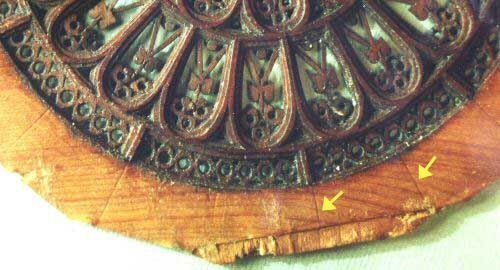
Image
3 The
basic division marking (of a circle in sections and concentric
rings) for the pattern of this rose was scribed by the maker directly
onto
the
upper layer
of
wood with the help of a sharp pointed tool and a pair of dividers.
The two layers of cypress (each of which is re-enforced with very
thin parchment from underneath) with the grain arranged in a crosswise
direction are clearly
visible
here.
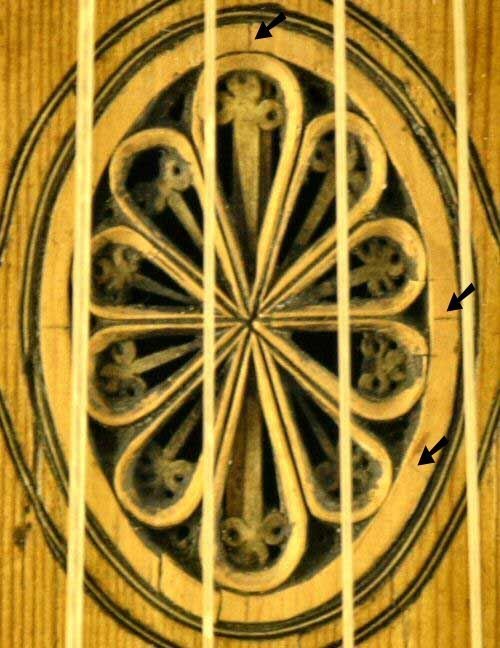
Image
4 Two-layer
wood and parchment “lazo a la tapa”rose on a tenor
viol by Henry Jaye, 1667 (V&A
museum, London). The upper layer appears to be made of boxwood,
also note tracing lines made with a sharp point, similar to those
found
on
the rose of the Sellas guitar (see image 3 above).
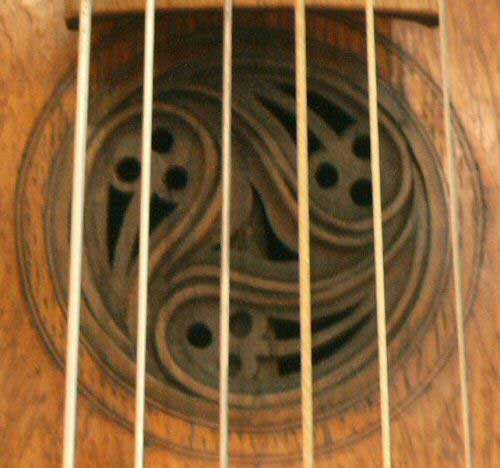
Image
5 Two-layer
(wood / wood or parchment?) “lazo a la tapa” rose on
the late 16th century viol attributed to Gasparo da Salò, Brescia
(Ashmolean museum, Oxford).

Image
6 Sunken “lazo
hondo” rose on a Venetian 16th century viol (Ashmolean
museum, Oxford). Also note square mosaic inlays similar to those
on the soundboard of the Jaquemart-Ándre vihuela.

Image
7 Carved
and gilded “lazo a la tapa” rose on the late 16th
Italian cittern by Gasparo da Salò (Ashmolean museum, Oxford).

Image
8 Carved “lazo
a la tapa” rose with underlying layer of parchment
on an anonymous mid - late 17th century Italian cittern from
the V&A
Museum: note that this rose is cut through the entire thickness
of the
soundboard (i.e. no noticeable reduction of soundboard thickness
in the area of the rose). In this case the layer of parchment on
the underside seems to serve both decorative and constructive
functions.

Image
9 Carved
and / or sawn “lazo a la tapa” rose on an Italian
c.1550 spinet (V & A museum, London). As
with the rose illustrated above, this example also appears to be
cut through the entire thickness of cypress soundboard.

Image
10
Multi layered wood and parchment rose used in a “lazo
a la tapa” way, as found on the 16th century Italian cittern
made by Giovanni Salvatori (Cite de la Musique, Paris).

Image
11 Signs
of usage of gouges on the bottom parchment layer of the rose from the
mid-17th century
guitar ascribed to the Sellas family
of makers (see also images 1, 2 & 3 above).
Image
12 Clockwise
from top left picture: mid 17th century Italian (or Spanish?) guitar
(Deutches
Museum, Munich), 16th
century Italian spinet (Kunsthistorishes
Museum, Nuremberg), mandolino by Francesco and Guiseppe
Presbler, Milan 1778 (RCM, London), mid - late 18th century
Spanish guitar* (private collection, Spain).
*
Many thanks to Jaume Bosser for allowing to publish this photograph.
|













